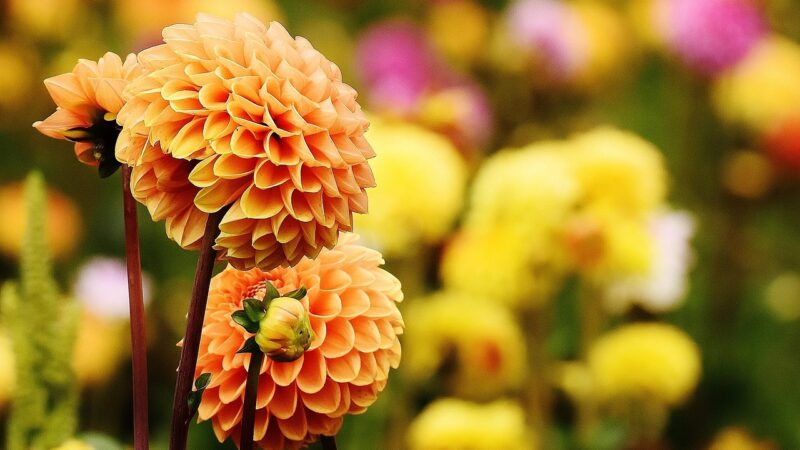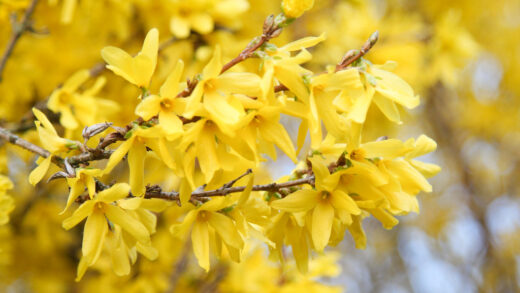The care of the dahlia

Mastering the art of dahlia cultivation is a rewarding journey that transforms any garden into a vibrant tapestry of color and form. These stunning flowers, with their diverse shapes and sizes, demand attentive care to reach their full potential, but the spectacular display they provide from midsummer until the first frost is well worth the effort. Successful dahlia care hinges on understanding their fundamental needs, from soil preparation and planting to ongoing maintenance throughout the growing season. Providing the right conditions not only ensures a wealth of blooms but also promotes strong, healthy plants that are more resilient to pests and diseases. This comprehensive guide will walk you through the essential practices that form the foundation of exceptional dahlia cultivation.
Preparing the foundation for success
Proper soil preparation is the first and most critical step in successful dahlia cultivation, as it directly impacts the health and vigor of the tuber and the subsequent plant. Dahlias thrive in well-drained, fertile soil with a slightly acidic to neutral pH, ideally between 6.5 and 7.0. Before planting, it is crucial to amend the soil to create this optimal environment. Heavy clay soils must be improved to prevent waterlogging, which can lead to tuber rot, while sandy soils need enrichment to retain necessary moisture and nutrients. Incorporating several inches of well-rotted compost or manure is an excellent way to improve soil structure, aeration, and fertility for any soil type.
The process of soil amendment should be done thoughtfully and thoroughly to ensure the benefits are distributed throughout the root zone. Begin by clearing the intended planting area of all weeds and debris, then spread a generous layer of your chosen organic matter over the surface. Using a garden fork or tiller, work this material into the top 10-12 inches of the soil, as this is the depth where the dahlia’s primary roots will develop. This deep cultivation not only mixes in the amendments but also loosens compacted soil, allowing for easier root penetration and better water infiltration. Taking the time for this foundational work pays significant dividends in plant health and bloom production.
Beyond the initial incorporation of organic matter, a soil test can provide invaluable insights into its specific nutritional composition and pH level. A test will reveal any deficiencies in essential macronutrients like phosphorus and potassium, which are vital for strong root development and prolific flowering. Based on the results, you can apply a balanced, low-nitrogen granular fertilizer at the time of preparation to ensure the tubers have access to the nutrients they need from the moment they are planted. Avoid high-nitrogen fertilizers at this stage, as they encourage excessive leafy growth at the expense of flowers.
Finally, consider the physical location and structure of the garden bed itself as part of the preparation. Dahlias require excellent drainage, so if your garden is prone to standing water, creating raised beds is an effective solution. A raised bed, typically 8 to 12 inches high, filled with a high-quality mix of topsoil and compost, ensures that the tubers are never sitting in waterlogged conditions. This elevated position also allows the soil to warm up faster in the spring, promoting earlier growth and giving your dahlias a strong start to the season.
More articles on this topic
Seasonal maintenance throughout the growing cycle
As dahlias begin their active growth phase in late spring and early summer, consistent and proactive care becomes essential for maintaining plant health and encouraging a continuous display of flowers. One of the first tasks is to provide support for taller varieties, which can easily be damaged by wind or the weight of their own blooms. Staking should be done at the time of planting or shortly after the first shoots appear to avoid damaging the tuber and root system later on. A single sturdy stake per plant or a more elaborate caging system can be used, with plant ties loosely securing the main stems as they grow.
Regular weeding is another critical aspect of seasonal maintenance, as weeds compete with dahlias for water, nutrients, and sunlight. A thick layer of organic mulch, such as straw, shredded bark, or compost, applied around the base of the plants can significantly suppress weed growth. Mulching offers the additional benefits of conserving soil moisture by reducing evaporation and regulating soil temperature, keeping the root zone cooler during the heat of summer. Ensure the mulch is a few inches away from the main stem to prevent rot and allow for proper air circulation.
As the season progresses, the focus shifts to maximizing bloom production through a practice known as deadheading. This involves the regular removal of spent or faded flowers, which prevents the plant from expending energy on seed production and redirects that energy into creating new buds and blooms. To properly deadhead a dahlia, trace the stem of the faded flower back to the main stalk and make a clean cut just above a set of leaves. This technique not only keeps the plant looking tidy but is arguably the single most important activity for ensuring a prolific flowering season that extends well into the autumn.
Monitoring plant health is an ongoing task that requires regular inspection of the leaves, stems, and flowers for any signs of trouble. Early detection of pests like aphids, spider mites, or thrips, or diseases such as powdery mildew, allows for prompt intervention before the problem becomes widespread. Check the undersides of leaves and the junctions of stems, as these are common hiding spots for pests. A healthy, well-cared-for dahlia is naturally more resistant to these issues, but vigilance is key to addressing any problems that may arise and ensuring the plant remains vigorous and productive.
More articles on this topic
The critical role of staking and support
Providing adequate support is a non-negotiable aspect of caring for most dahlia varieties, especially the larger-flowered dinnerplate types and those that grow over three feet tall. Without proper staking, the hollow, brittle stems are highly susceptible to snapping under the weight of their magnificent blooms or during periods of strong wind and heavy rain. The failure to provide support can result in the heartbreaking loss of entire branches or even the main stalk, undoing months of careful cultivation. The best practice is to implement the support system early, either when planting the tuber or when the plant is no more than a foot tall.
There are several effective methods for staking dahlias, and the choice often depends on the size of the plant and the gardener’s preference. The simplest method involves placing a single, sturdy stake, made of bamboo, wood, or metal, about 4-6 inches from the base of the plant at planting time. As the main stem grows, it can be loosely tied to the stake at regular intervals using soft plant ties, twine, or strips of fabric. It is crucial that the ties are not too tight, as this can constrict and damage the stem as it thickens throughout the season.
For gardeners growing multiple dahlias in a row or a dense bed, the corral method offers a more efficient and robust support solution. This involves driving stakes into the ground at the corners of the bed and every few feet along the perimeter. Strong garden twine is then run between the stakes at several heights, typically at 12, 24, and 36 inches from the ground, creating a grid-like enclosure. The dahlias grow up within this corral, using the network of twine for support, which often results in a more natural-looking display than individual stakes.
Another excellent option, particularly for single specimen plants, is the use of a tomato cage or a similar circular support structure. These cages provide all-around support and are very easy to install over the young plant. The dahlia grows up through the center of the cage, and its lateral branches can rest on the horizontal rings for stability. This method is particularly useful for bushier varieties, as it helps maintain a well-contained and upright shape while protecting the stems from all directions.
Promoting blooms through deadheading and disbudding
Deadheading is an essential horticultural practice that significantly extends the blooming period and increases the overall flower yield of dahlia plants. The primary goal of any flowering plant is to produce seeds for reproduction, and once a flower is pollinated and begins to fade, it directs its energy toward this task. By promptly removing these spent blossoms, you interrupt the seed-making process, signaling the plant to produce more flowers in its effort to successfully reproduce. This simple act of maintenance is the key to enjoying a continuous and abundant display of dahlia blooms from midsummer until the first frost.
The technique for deadheading dahlias is important for encouraging the right kind of new growth. It is not enough to simply pull off the old petals; the entire flower head and its stem must be removed. A spent dahlia flower can be distinguished from a new bud by its shape; buds are typically round and firm, while finished blooms are more pointed or cone-shaped. To correctly deadhead, follow the stem of the faded flower down to the point where it meets a main branch or a set of leaves, and make a clean cut just above this junction. This encourages the plant to branch out and produce new flowering stems from that point.
While deadheading promotes more flowers, a different technique called disbudding is used to achieve larger, exhibition-quality blooms. This practice is most common with the large-flowered dahlia varieties. Dahlias typically produce buds in clusters of three at the end of a stem: a central terminal bud and two smaller side buds. To disbud, you carefully pinch off the two side buds, leaving only the central bud to develop. This allows the plant to channel all its energy and resources into producing one single, but exceptionally large and perfectly formed, flower on that stem.
Deciding whether to prioritize a higher quantity of flowers or larger individual blooms is a matter of personal gardening goals. For a stunning garden display or a continuous supply of cut flowers for bouquets, regular deadheading is the preferred approach, as it ensures the plant remains productive over a long season. For those competing in flower shows or aiming to grow the most impressive dinnerplate dahlias possible, the meticulous practice of disbudding is necessary. Many gardeners employ a hybrid approach, disbudding a few select stems for showstopper blooms while allowing the rest of the plant to flower naturally with simple deadheading.
The importance of mulching
Mulching is a simple yet highly effective gardening technique that provides numerous benefits for dahlia care, contributing significantly to the overall health and vigor of the plants. Applying a layer of organic material over the soil surface around the base of the dahlias helps to create a more stable and favorable root environment. One of the primary advantages of mulch is its ability to conserve soil moisture. By acting as a barrier, it reduces the rate of water evaporation from the sun and wind, meaning the soil stays hydrated for longer periods and watering frequency can be reduced.
Another key benefit of mulching is its role in weed suppression. A thick layer of mulch, ideally 2 to 3 inches deep, blocks sunlight from reaching the soil surface, which prevents many common weed seeds from germinating. For any weeds that do manage to sprout, the loose mulch layer makes them much easier to pull. This reduction in weed competition is crucial, as it ensures that the dahlias have exclusive access to available water, nutrients, and space, allowing them to grow stronger and more robust without being hindered by unwanted plants.
Mulch also plays a vital role in regulating soil temperature. During the hot summer months, it helps to keep the soil cooler, protecting the sensitive dahlia root system from heat stress and promoting optimal function. Conversely, in the cooler temperatures of spring and autumn, it can help to retain warmth in the soil. This temperature moderation creates a more consistent environment for the roots, reducing stress on the plant and contributing to more stable and healthy growth throughout the entire season.
As an added bonus, the use of organic mulches like compost, shredded leaves, or straw gradually improves the soil structure and fertility over time. As these materials slowly decompose, they release valuable nutrients into the soil and increase its organic matter content. This process enhances soil aeration, improves drainage in heavy soils, and increases water retention in sandy soils. When applying mulch, it is important to keep it a few inches away from the main stem of the dahlia to prevent moisture from being trapped against the stem, which could lead to rot or fungal issues.
Preparing dahlias for the end of season
As the vibrant spectacle of summer draws to a close and the cooler temperatures of autumn arrive, the focus of dahlia care shifts towards preparing the plants for the end of the growing season and dormancy. This preparatory phase is crucial for ensuring the health and survival of the tubers, which will be the source of the following year’s display. One of the first changes in care involves adjusting the fertilization schedule. It is important to stop feeding dahlias with any nitrogen-rich fertilizers by late summer, as this discourages the growth of new, tender foliage that would be vulnerable to the first frost.
As autumn progresses, you can allow the plants to continue blooming until they are naturally stopped by the weather. The first light frost will typically blacken the foliage and signal the end of the active growing period. While this may look unsightly, it is a necessary trigger for the plant to enter dormancy. After the foliage has been blackened by frost, it is recommended to wait for about a week or two before cutting the plant back. This waiting period allows the plant to draw the last of its energy from the stems and leaves and store it in the tuber, a process that is vital for its winter survival and subsequent spring growth.
Once the waiting period is over, the dahlia stalks should be cut down to a height of about 4 to 6 inches above the ground. This short stalk serves as a convenient handle for lifting the tuber clump from the soil and helps with labeling if you are growing multiple varieties. Be sure to use clean, sharp pruners or loppers to make a clean cut and minimize any damage to the plant’s crown. At this stage, it is also a good practice to loosely tie the variety tag to the remaining stalk so that identification is not lost during the lifting and storage process.
The final step in the end-of-season preparation is deciding whether to lift the tubers for winter storage or, in milder climates, to leave them in the ground with heavy protection. For most regions where the ground freezes, lifting the tubers is essential to prevent them from freezing and rotting. In zones with very mild winters, a thick layer of mulch, such as 12 inches of straw or shredded leaves, may be sufficient to insulate the tubers and allow them to overwinter in the garden. However, lifting and storing them indoors provides the most reliable method for preserving your valuable dahlia collection.
Avoiding common dahlia care mistakes
Even with the best intentions, gardeners can sometimes make common mistakes that hinder the performance and health of their dahlia plants. One of the most frequent errors is overwatering, especially in the early stages of growth. Dahlia tubers are highly susceptible to rot in cold, wet soil, so after the initial planting, they should not be watered again until the first green shoots appear above the ground. Once the plant is actively growing, it requires consistent moisture, but the soil should never be allowed to become waterlogged. A good rule of thumb is to water deeply and less frequently, allowing the top inch of soil to dry out between waterings.
Another common pitfall is improper fertilization. While dahlias are heavy feeders, providing them with the wrong type of nutrients can lead to disappointing results. The most significant mistake is using a fertilizer that is too high in nitrogen. Excess nitrogen promotes lush, dense foliage at the expense of flower production, resulting in a large green bush with very few blooms. To encourage a profusion of flowers, it is best to use a balanced fertilizer or one that is specifically formulated for blooms, which will have a higher concentration of phosphorus and potassium (the ‘P’ and ‘K’ in N-P-K).
Neglecting to provide adequate support for taller dahlia varieties is a mistake that often leads to heartbreak. Gardeners may underestimate how large and heavy the plants will become, and by the time they realize support is needed, the stems may already be stressed or damaged. As previously mentioned, it is crucial to install stakes or other support structures at the time of planting or when the plant is still young. Attempting to drive a stake into the ground near a mature plant risks piercing the delicate tuber clump, which can cause significant damage or introduce disease.
Finally, a lack of attention to spacing when planting can create problems later in the season. Dahlia plants need good air circulation to help prevent fungal diseases like powdery mildew. If they are planted too closely together, the dense foliage can trap humidity and create an ideal environment for pathogens to thrive. Overcrowding also leads to increased competition for sunlight, water, and nutrients, which can result in weaker plants and reduced flowering. Be sure to follow the spacing recommendations for your specific dahlia varieties, which can range from 12 inches for smaller types to 24 inches or more for the large, vigorous cultivars.



















